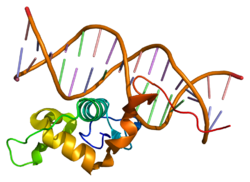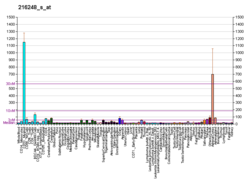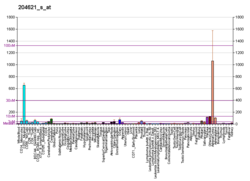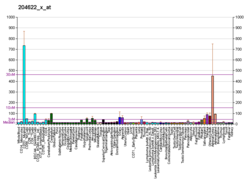The nuclear receptor 4A2 (NR4A2) (nuclear receptor subfamily 4 group A member 2) also known as nuclear receptor related 1 protein (NURR1) is a protein that in humans is encoded by the NR4A2 gene.[5] NR4A2 is a member of the nuclear receptor family of intracellular transcription factors.
NR4A2 plays a key role in the maintenance of the dopaminergic system of the brain.[6] Mutations in this gene have been associated with disorders related to dopaminergic dysfunction, including Parkinson's disease and schizophrenia. Misregulation of this gene may be associated with rheumatoid arthritis. Four transcript variants encoding four distinct isoforms have been identified for this gene. Additional alternate splice variants may exist, but their full-length nature has not been determined.[7]
This protein is thought to be critical to development of the dopamine phenotype in the midbrain, as mice without NR4A2 are lacking expression of this phenotype. This is further confirmed by studies showing that when forcing NR4A2 expression in naïve precursor cells, there is complete dopamine phenotype gene expression.[8]
While NR4A2 is a key protein, there are other factors required as research shows that solely expressing NR4A2 fails to stimulate this phenotypic gene expression. One of these suggested factors is winged-helix transcription factor 2 (Foxa2). Studies have found these two factors to be within the same region of developing dopaminergic neurons, both of these factors were present in order to have expression for the dopamine phenotype. [8]
- ^ a b c GRCh38: Ensembl release 89: ENSG00000153234 – Ensembl, May 2017
- ^ a b c GRCm38: Ensembl release 89: ENSMUSG00000026826 – Ensembl, May 2017
- ^ "Human PubMed Reference:". National Center for Biotechnology Information, U.S. National Library of Medicine.
- ^ "Mouse PubMed Reference:". National Center for Biotechnology Information, U.S. National Library of Medicine.
- ^ Okabe T, Takayanagi R, Imasaki K, Haji M, Nawata H, Watanabe T (April 1995). "cDNA cloning of a NGFI-B/nur77-related transcription factor from an apoptotic human T cell line". Journal of Immunology. 154 (8): 3871–3879. doi:10.4049/jimmunol.154.8.3871. PMID 7706727. S2CID 36075352.
- ^ Sacchetti P, Carpentier R, Ségard P, Olivé-Cren C, Lefebvre P (2006). "Multiple signaling pathways regulate the transcriptional activity of the orphan nuclear receptor NURR1". Nucleic Acids Research. 34 (19): 5515–5527. doi:10.1093/nar/gkl712. PMC 1636490. PMID 17020917.
- ^ "Entrez Gene: NR4A2 nuclear receptor subfamily 4, group A, member 2".
- ^ a b Yi SH, He XB, Rhee YH, Park CH, Takizawa T, Nakashima K, Lee SH (February 2014). "Foxa2 acts as a co-activator potentiating expression of the Nurr1-induced DA phenotype via epigenetic regulation". Development. 141 (4): 761–772. doi:10.1242/dev.095802. PMID 24496614. S2CID 16677797.







